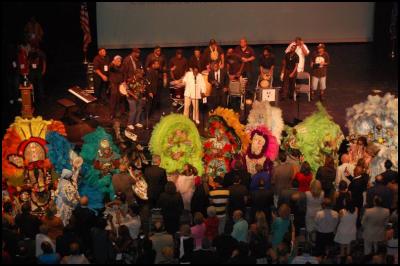Stateside: Stacey Knott on Life And Death In New Orleans
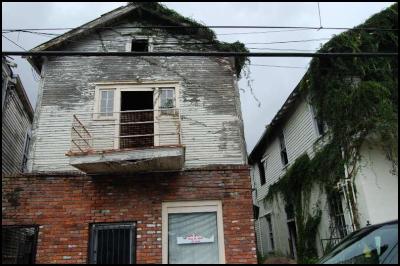
Drunkenness on Bourbon Street, Mardi Gras, fresh shrimp and ghost tours have all returned since Hurricane Katrina hit New Orleans, but some neighbourhoods are still hounded by poverty, rotting homes and crime as Kiwi journalist Stacey Knott discovered this week - the fifth anniversary of “The Storm”.
Having just moved to New Orleans in time for the fifth anniversary of Hurricane Katrina, I decided to venture out of the safety of the central city to some of the hardest hit neighbourhoods to hear peoples' stories, and see the destruction still evident five years later.Hearing locals talk about the storm and how New Orleans has changed since was both heartbreaking and humbling, and the strength and resilience of the people was one of the most inspiring things I have experienced.
Because of the storm and subsequent levee breeches, 80 percent of New Orleans was flooded. In some parts of the city, there is little evidence of this destruction, while other parts still wear the pain of it all.
About a ten minute drive from the iconic French Quarter is the now infamous Lower Ninth Ward, also known as “Ground Zero” of the hurricane, where there is still ample evidence of Katrina's destruction.
Throughout New Orleans on the fifth anniversary of Katrina, there was commiseration, celebration, determination, dance, music, anger and tears. But as grey clouds lingered and bursts of rain drenched commemoration events, the mood was anything but sombre.
Like at a mock funeral for Hurricane Katrina in St Bernard's Parish where people put notes in a coffin for Katrina, but unlike a normal funeral, when the casket closed, everyone applauded. New Orleans Archbishop Greg Aymond said the event was to “let Katrina die,” and signified that “Katrina's spirit of disaster no longer lives in New Orleans.”
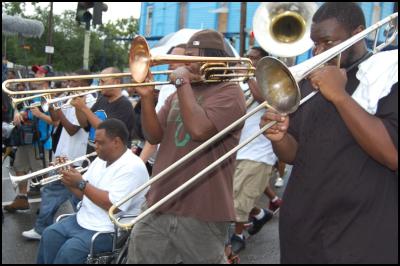
I attended a block party held to celebrate the work done by a local group who rebuild homes for low income, elderly and disabled residents, for free.
It was there I met Jeanne Bourgeois, developing director for the group Rebuilding Together New Orleans, a non-profit group which had just spent the week rebuilding 50 homes in New Orleans affected by Katrina.
Since 2005 the organisation has been constantly busy repairing and rebuilding homes at no cost to residents.
Bourgeois, a New Orleans native, was living in California when Katrina hit but came back four weeks after it hit to help friends and family.
“It was one of the most difficult and devastating things I have ever seen,” she said.
She recalls driving around the city and noticing “no lights and no sound. I got out of the car and sat there and cried like a child because I thought my city had lost her soul for a minute, but not for long because we always bounce back. It hurt me for people I don't know, it hurt me for my city to experience raw physical and emotional abandonment.”
She felt the recovery was “coming along wonderfully”, but aknowledged for some areas it was going to take longer.
“Areas people know about like the Ninth Ward are coming back, they have had support and focus, not enough, but it is coming back.”
But after visiting the Ninth Ward and witnessing the desolation there and talking to residents it was hard to see how it was “coming back”.
The Ninth Ward was almost completely submerged after levees along the Industrial Canal between the Mississippi River and Lake Pontchartrain failed.
Residents told me stories of up to 10 feet of water inside their houses, being forced into attics and on roofs to escape the floods and using whatever buoyant materials they could find to survive.
The people of the Ninth Ward commemorated the hurricane by holding a march and a traditional New Orleanian “Second Line”, a parade centered around a brass band, and a core group of dancers.
I decided to attend this particular event because it went through an area that still clearly wears the scars of Katrina.
We marched in the pouring rain, chanting, singing, and dancing, and listened to residents share their harrowing stories over a megaphone.
The parade encouraged people from their homes to join in or dance on the side of the road as we passed.
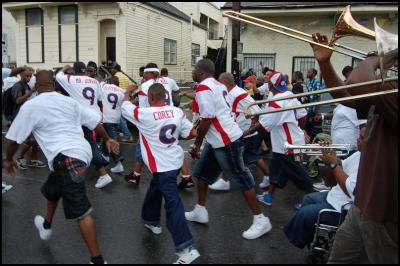
On the march I met Marzuk, a freelance writer and home owner in the Lower Ninth Ward, who while pleased at the turn out at the march, gave me and idea of the harsh reality of living in the area.
“I just wish they would get rid of the thugs that are out here stealing from people, preventing them from rebuilding,” he said.
He had been living in Washington DC when Katrina hit, but his family were still in New Orleans.
As soon as he heard the news he was determined to move back and help his city.
“I came back because it's home, I want to help rebuild home,” he said.
When it comes to rebuilding and the cleanup, he still holds anger towards the local and US Government.
He likens looking to those two bodies for help as “a person to look to someone who robbed their house to have them come in and say 'let me help you get the stuff back we took out'.”
He said he did not look to the Bush Administration for anything, nor the previous mayor, but he says the new mayor is making big changes “you can see, feel and smell the change.”
He was optimistic about his neighborhood coming back as long as people “pull together”.
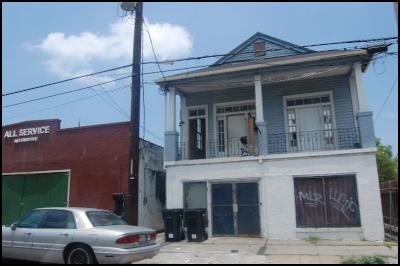
Also at the march was Young Sino, a record store owner and performer, who was born and raised in a housing project in the Ninth Ward.
He was in college in neighboring city Baton Rouge when Katrina hit, so instead of going home to New Orleans for the weekend as he usually did, he stayed in his two bedroom apartment and had 22 family and friends come stay while the storm washed away all they knew in New Orleans.
His grandmother's home was damaged by nine feet of water. She stayed back when the storm hit, and was rescued from her home on the third day of the storm.
Sino could see how those in richer neighborhoods would be optimistic about the rebuilding efforts in New Orleans, but he felt the urban mostly black populated parts of the city were being ignored.
He was particularly vexed about the lack of schools in his neighbourhood.
“That's one thing we still deal with each and every day because there are still not a lot of schools open for the kids and there still not a lot of healthcare.
“How could you bring the Superdome back before the schools back? To me that is saying you care more about football than our children. We got to get back to caring about human life than caring about what makes our pockets bigger.”
He talked about the crime rates in New Orleans, and said when more effort is put into the neighbourhood, then peoples spirits will be lifted, and there will be less crime.
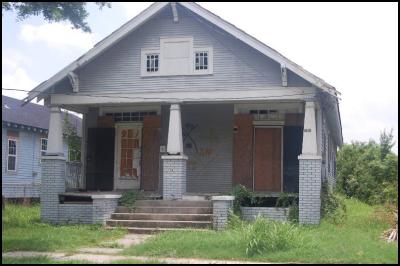
Sino's sentiments were echoed by dancers and Seventh Ward residents Pervella Gant and Dakema Paynes.
Gant was forced to seek out higher ground on a road, where she remained for three days following Katrina, while Paynes returned to New Orleans from Atlanta to find she had absolutely nothing left.
Gant described the mayhem that prevailed.
“For them [the Government] to know a hurricane as bad as Katrina was coming, a category five, they should have got everybody out of the city. When it came that night everybody should have been evacuated that morning but instead they took their time and people starved and went into blistering heat, no clothes no shelter, people sleeping on roofs, on concrete, a branch on the interstate. You have guns in your face, people shooting you for no reason, it was like World War Three”.
Since the storm, they have both noticed more poverty, more murders and more homeless on the streets, they have also found it harder for people to get jobs.
“You would think the Government and the city would get together and put more into the city but they are taking their time while people are in need. It feels like nobody cares. Like we don't have help and we have been left out.”
They are still “absolutely angry” about it, but say they thank god for the charitable groups who want to help New Orleans.
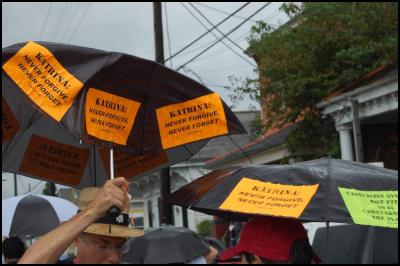
While the anger is still in New Orleans, and people will remember Katrina for the rest of their lives, there is still hope and optimism, especially from the face of New Orleans Mayor Mitch Landrieu.
An event to conclude the anniversary was held at the Mahalia Jackson Theatre where Landrieu was joined by 12 Mardi Gras Indians in full regalia, a brass band, and New Orleans musical groups.
Landrieu who has been in power for six months gave a motivating and heartfelt speech at the event.
“We must think back and remember to what seems like so long ago. The days and moments that have been etched into our memories flood back like the rising water. Oppressive heat and pitch black nights, the confusion and the fear, it all rushes back; a torrent of sights, sounds and smells,” he said.
He spoke of the haunting memories of the hum of motorboats and the silence of corpses lying face down in the water, also of a “mighty Mardi Gras Indian headdress, swept away. A favourite blanket or dress left behind now gone. So many photo albums, letters, birthday cards, and recipes lost in the water, forever.”
Since the event, he said ““every time we say goodnight we said it to someone we lost”.
But then things got better, he said.
“We were battered, bruised and scarred. But with grit, determination and help, the people of this city rose out of the water, bearing the burden together that none of us could bear alone.”
He concluded his speech with what everyone in the room, and perhaps the city seemed to be feeling: that “it is time to turn tragedy into triumph” because “come hell or high water we ain't going nowhere”.
